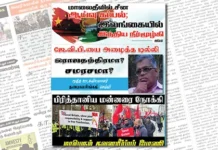The international media watchdog Committee to Protect Journalists (C.P.J.) called on the Sri Lankan Police to stop harassing Tamil journalist Punniyamoorthy Sasikaran in Batticaloa and “let him work without interference.”
The statement explains, “On August 23, officers from the Batticaloa police superintendent’s Special Crime Branch interrogated Sasikaran, a freelance Tamil journalist who is also the treasurer of the Batticaloa District Tamil Journalists Union, at a police station, according to news reports and the journalist, who communicated with C.P.J. by messaging app.
The officers accused Sasikaran of organizing a ceremony in January that paid tribute to Indian fishermen who died at sea in 2020, which he said he merely covered as a journalist, he told C.P.J. Authorities released him after about two hours, he said.
C.P.J. emailed U.P.A.D.K.P. Karunanayake, the deputy inspector-general of the Batticaloa district police, for comment and to determine if Sasikaran had been formally charged with a crime, but did not receive any reply.
“It’s time for Sri Lanka’s police to call off their repeated harassing interrogations of journalist Punniyamoorthy Sasikaran and allow him to go about his work without interference,” said Steven Butler, C.P.J.’s Asia program coordinator. “Police should not be using intimidation tactics to prevent journalist from covering protests by Sri Lanka’s Tamil community, or any others.”
Police have repeatedly interrogated Sasikaran over his alleged planning of that January event, as well as a February 3 to 7 protest calling on the government to resolve issues facing Tamils, as C.P.J. has documented.
In July, officers with the Terrorism Investigation Division also interrogated Selvakumar Nilanthan, a freelance Tamil journalist and secretary of the Batticoloa District Tamil Journalists Association, as C.P.J. documented at the time.”





